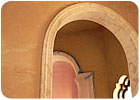
Two thousand years ago, before there was global warming, high energy prices and concerns about breathing VOCs (Volatile Organic Compounds), Roman builders perfected energy efficient, mold resistant and healthy plasters that they used for covering interior and exterior walls of their homes and public buildings. In places like Pompeii we can still see the impressive colors and durability of these plasters and natural mineral pigments, which are now receiving welcome appreciation as consumers look for materials that will reduce operating expenses, protect their health and offer a breathtaking decorative look.
Pure lime plasters became less of a mainstay in the late 1800s with the invention of Portland cement. Recently, the use of authentic lime plasters has revived as part of the restoration movement of famous buildings and historic residences in Europe and the United States.
Lime plasters from Italy are most generally referred to as “Venetian”. In the Middle Ages, Venetian architects placed real marble slabs on buildings only to find that they increased the settling (yes, they knew the city was sinking in the 14th century), so they applied a stucco veneer of thin layers of lime plaster over brick or wood walls to reduce weight. The application techniques they perfected created a lustrous finish that looks like marble or travertine stone. Once dry, the limestone veneer can last for hundreds of years. It is easily repaired and offers a high gloss marble finish.
Lime plasters have been used since the Sumerians first discovered them in 4,000 BC, and are found in major cultures around the world. However, the finest lime plasters come from Italy. That’s because the Italian peninsula juts out into the Mediterranean Sea and its rich limestone deposits underlie the entire country.

Today’s homeowner can use an Italian plaster in virtually every room and surface; floors, columns, walls, ceilings and counters. Venetian plasters with the finest grains of marble are used on walls. By adding marble grains with increasingly larger microns to the lime putty, a variety of interesting designs can be achieved. Grassello is used to create fanciful flourishes and uses a fine grade of marble powder, while Travertino, because it has the largest grains, provides a rustic finish on walls and counters. Tadelakt, the smooth Moroccan plastering technique is used to create an organic look for tubs, showers, walls, ceilings, floors, fountains and furniture. It is waterproof (after waxing) and is still in use throughout Morocco today.
The cost of natural products like lime plasters is competitive with other coatings while contributing to savings in energy and upkeep. Lime plasters may be used to help qualify a structure for green certification under the LEED system established by the U.S. Green Building Council. Architects and builders can earn up to four points for using these plasters.
In addition to beautiful finishes, the remarkably durable and beautiful surfaces actually “breathe” expelling moisture throughout their lifetime. They are mold and mildew resistant and have no VOC’s so they are safe during application and for the lifetime of the structure they are placed in.
